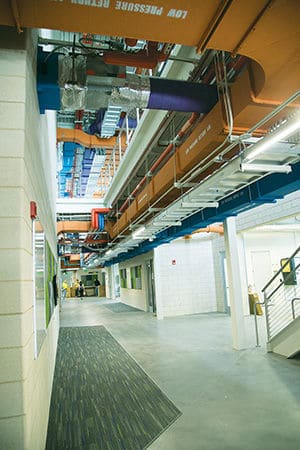As the Fort Worth area continues its rapid growth, there is an increasing demand for industrial workers. According to the Social Security Administration, the number of heating, ventilation, air conditioning and refrigeration (HVACR) positions will increase by 21 percent before the year 2022, resulting in a need to train 115,000 new individuals nationally to keep pace with demand. Locally, the need for highly skilled industrial workers will increase 10-15 percent annually over the next 15 years.
Part of this demand is driven by an increased level of commercial and residential construction across the region. After all, building a structure without air conditioning in Texas is simply not an option since summer temperatures often exceed 100 degrees. In addition to growth, there are fewer industrial workers available as more of them reach retirement age. Approximately 22 percent of the current industrial workforce will retire by 2022.
In response to this need, Tarrant County College decided to expand its HVAC program by creating the Center of Excellence for Energy Technology. The center increases TCC’s capacity to train students seeking industrial vocational skills as well as enables the school to offer new programs such as geothermal technology, wind generation, active solar, oil and gas technology and industrial technology.
Using the Ferris State University facility for HVACR and Engineering Training as a model, TCC partnered with Freese and Nichols, a Fort Worth-based engineering firm, and with BNIM, a Kansas City-based architecture firm, to create a structure to host the Center of Excellence for Energy Technology. This innovative building uses technology to create an engaging learning environment while also serving as a model of sustainable building and conservation practices.
From the moment students walk into the building, it is obvious that every aspect of the center is designed for interactive learning. The most obvious difference is found among the open ceilings and see-through walls. Pipes, duct work and other equipment are labeled, color-coded by function and completely exposed so that students can see how the systems fit together. Instructors can walk their students around the building and point out the actual features, rather than simply rely on videos or illustrations.
Another difference is visual access to the mechanical rooms. These areas are centrally located behind storefront walls and easily accessible for observation.
One of the most prominent features in the facility is the air duct fabrication laboratory. The lab features a small-scale home simulating the conditions that students will encounter when working at new home construction sites. As well, the lab provides a computer-operated laser cutting machine so students may learn how to create and install custom air duct panels. The equipment is widely used in the industry, but budget limitations mean few educational programs across the nation have the ability to train students how to use it.
While there is a great deal of emphasis on teaching students to use the latest technology, in the industrial trades it is equally important to provide them with knowledge about older equipment and systems so they can work in structures of any age. Equipment donated to the Center of Excellence for Energy Technology labs ensures that students receive hands-on training with a wide array of equipment so they are prepared to deal with any situation.
Sustainable building practices have also been integrated throughout the center. The most notable feature is the use of solar panels, which have been seamlessly incorporated into the public courtyard design as trellises. A wind turbine on the campus will provide students with first-hand exposure to another renewable energy technology.
Additional energy conservation features include the use of geothermal wells to help regulate the building temperature and the integration of daylight harvesting into the architectural design to reduce the use of artificial lighting. The wings of the building were created in an “H” shape to allow daylight into more of the interior sections.
The building also includes some hands-on stormwater management lessons that go far beyond the standard methods of underground pipes and retention ponds. The building’s public courtyard is composed of permeable pavers and bioretention swales that remove pollutants and then release water into the soil to irrigate landscaping features or slowly drain into the city’s stormwater system.
TCC anticipates that the Center of Excellence for Energy Technology will create a new kind of student who is equipped with a wide range of industrial skills. It is projected that the program will attract an additional 600 to 1,000 students over the next few years.
In order to reach this growth goal, TCC is working with local school districts to educate students, especially those in disadvantaged communities, about the related job opportunities and salaries. In addition to recruiting new students, TCC is attracting a number of industry veterans who want to brush up their skills by learning the latest technologies. As well, TCC continues to work with local companies to design courses specific to the companies’ needs.
Allen McRee is an associate at Freese and Nichols and served as project manager for the Center of Excellence for Energy Technology.






